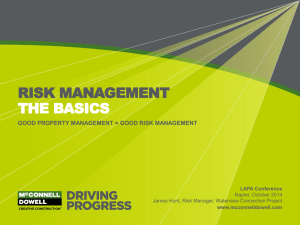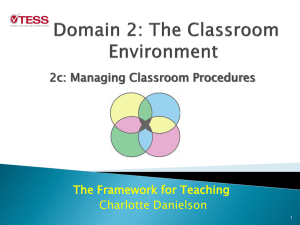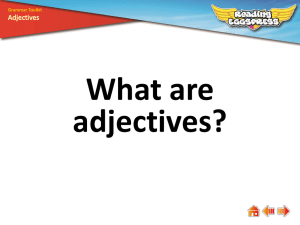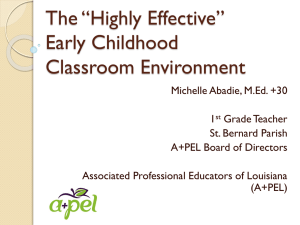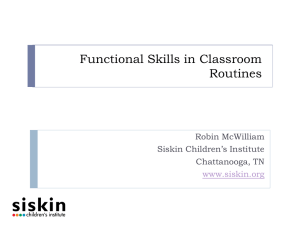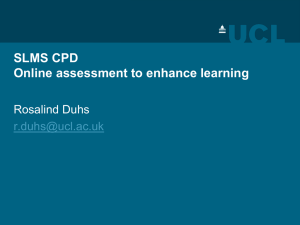Routines and Transitions - Alliance TCRP Updates and Information
advertisement
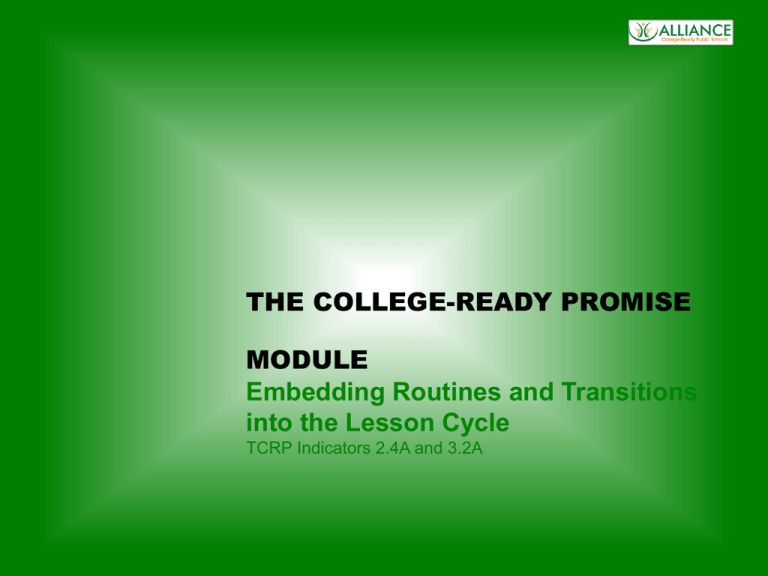
THE COLLEGE-READY PROMISE MODULE Embedding Routines and Transitions into the Lesson Cycle TCRP Indicators 2.4A and 3.2A Objectives • Discuss and practice techniques to maximize instructional time in the two-hour block by embedding routines and procedures. • Learn techniques relating to two TCRP indicators: – 2.4a: Smooth, efficient transitions, routines, procedures – 3.2a: Execution of lesson cycle Summer Conference 2011 2 Learning outcome Add to your instructional toolkit by: • Learning about the importance of establishing routines and managing transitions • Learning to set the purpose for learning each day • Exploring strategies for active participation that work across content areas • Learning about the gradual release model in terms of the lesson cycle Summer Conference 2011 3 What does the indicator say? TCRP 2.4a (Level III): “The teacher has established and enforces routines and procedures; transitions result in little loss of instructional time.” Summer Conference 2011 4 Establishing routines “A classroom routine is simply a well-rehearsed response to a teacher's directive. The alternative is usually noise, milling around, and time wasting on the part of students, as well as nagging on the part of the teacher.” - Dr. Fred Jones, author and classroom management researcher “The only way to have responsible students and to help students who may be at-risk is to have procedures and routines for which the students can feel responsible.” - Harry Wong, The First Days of School Summer Conference 2011 5 Consider this … Using routines to cut 1 minute from 10 transitions per day over the course of a school year can gain you an additional 35 hours of instructional time. Summer Conference 2011 6 Write and reflect … In light of what you already know about the workings of a classroom … • Affirmation: What did you hear that affirms what you already know? • Inspiration: What did you hear that inspired you to do something differently? • Clarification: What is unclear that you would like to have clarified? Summer Conference 2011 7 Routine = response Instead of telling and posting, teach and practice crucial classroom routines. “Your instincts will tell you that you are wasting time [teaching routines], but the opposite is true. Look at it as making an investment.” - Doug Lemov, Teach Like a Champion Summer Conference 2011 8 Establishing routines The effective classroom has well thought-out and structured routines and procedures • • • • Consistency of expectations Predictability of what help will be given Anticipation of what is going to happen next Practice of new skills in natural, functional contexts Summer Conference 2011 9 Toolkit basics: SLANT Use ‘shorthand’ to cue students as they practice and learn routines. This is one of the hallmarks of a highperforming classroom. S = Sit up in your seat L = Listen A = Ask and answer questions N = Nod your head and look engaged T = Track the speaker with your eyes Summer Conference 2011 10 Toolkit basics: STAR S = Sit up in your seat T = Track the speaker with your eyes A = Ask and answer questions like a scholar R = Respect those around you Summer Conference 2011 11 Toolkit basics: Do now • Do Now (First 5-10 minutes of class) – Self-managed habit of productive work – On the board in the same place daily – Preview or review only – Pencil and paper task • Written product is more rigorous and engaging • Holds students accountable Summer Conference 2011 12 Toolkit basics: Do now Sample ‘do now’ - Find The Question • Choose 5-10 words or phrases. • Tell students these are answers and that their job is to think of a question for each one. • Answers could be general (e.g. ‘the sea’), to encourage creative thinking. • Answers could be “closed” to gain a specific response. – Answer: Curley’s wife – Question: Who did Lennie accidentally kill in Of Mice and Men? Summer Conference 2011 13 Write a ‘do now’ 1. Set a goal. Review previous day or give a sneak peek at what is to come. 2. Decide on a time limit. (5-10 minutes) 3. Select a delivery method. (White board, LCD, overhead, etc.) 4. Select how students will respond. (In writing, on scratch paper, in lab notebook, etc.) 5. Decide how you will assess the outcome. We will share out in 5 minutes. Summer Conference 2011 14 Write and reflect … In light of what you already know about building a culture with ‘shorthand’ cues and starting class with a ‘do-now’ activity … • Affirmation: What did you hear that affirms what you already know? • Inspiration: What did you hear that inspired you to do something differently? • Clarification: What is unclear that you would like to have clarified? Summer Conference 2011 15 What does the indicator say? TCRP 3.2a (Level III): “Teacher implements the lesson cycle with appropriate pacing, which provides opportunities for gradual release and independent practice to demonstrate attainment of the learning objectives.” Summer Conference 2011 16 Toolkit basics: Establishing purpose Transition to content with a “focus lesson” • • • • Foundational instructional strategy Based on standards and Instructional Guide Critical to success of English language learners Cues the student to pay attention to key aspects of the lesson to come Summer Conference 2011 17 Target the dimensions of learning • • • • Declarative – What is it? Procedural – How do I use it? Conditional – When/where do I use it? Reflective – How do I know I used it correctly? Summer Conference 2011 18 Follow a predictable pattern • Name the strategy, skill, or task. “Today I am going to …” • State the purpose. “It’s important to be able to … because …” • Explain when the strategy or skill is used. “I use this when …” Summer Conference 2011 19 Follow a predictable pattern • Use analogies to link prior knowledge to new learning. “This is like …” • Demonstrate how the skill, strategy, or task is completed. “This is what we will do …” Summer Conference 2011 20 Follow a predictable pattern • Demonstrate how the strategy, skill, or task is completed. Short summary of what is to come. • Alert learners for possible errors to avoid. “I have to be careful not to …” • Access the use of the skill. “I know I will have accomplished it because …” Summer Conference 2011 21 Toolkit basics: Focus lesson • Craft one focus lesson by group • Pick a creative topic for your “lesson” • Select one person to share out We will share out in 7 minutes. Summer Conference 2011 22 Write and reflect In light of what you already know about focus lessons … • Affirmation: What did you hear that affirms what you already know? • Inspiration: What did you hear that inspired you to do something differently? • Clarification: What is unclear that you would like to have clarified? Summer Conference 2011 23 Aim for active engagement How you deliver your lessons has a direct impact on how much your students will retain. Retention after 24 hours (Sousa, 2001) 5% - lecture 10% - reading 20% - audiovisual 30% - demonstration 50% - discussion group 75% - practice by doing 90% - teaching others/immediate use of learning Summer Conference 2011 24 Aim for active engagement Should lecture be avoided? • No – but limit it proportionately compared to other, more active strategies. • Try to plan for 10-20 minute bursts of lecture (direct instruction), which is the attention span of the average listener. • Change plans if you see students’ attention drifting. Summer Conference 2011 25 Pacing is not speed Pacing does not mean the speed at which you teach. It is the rate at which the lesson appears to make the material unfold as you use a variety of instructional strategies. Goals: • Engage and interest students. • Give students a sense of progress and change. Summer Conference 2011 26 Toolkit basics: Pacing Age + 2 = One way to roughly estimate the length of an activity to maximize attention span. Middle school frosh: 12 + 2 = 14 minutes High school senior: 17 + 2 = 19 minutes Summer Conference 2011 27 Toolkit basics: Pacing Start and stop activities cleanly to create an illusion of progress and change. Bound each activity with finite time limits. Example: “Take exactly 3 minutes to answer the question in front of you.” Summer Conference 2011 28 Toolkit basics: Pacing Pacing and engagement strategy: Cold call Ask a question and then call the name of the student whom you would like to answer it. Caution! This only works if you explain it and use it systematically. It is not a disciplinary strategy! Summer Conference 2011 29 Toolkit basics: Pacing Cold call: • • • • • Predictable strategy Students become used to being asked to participate. Allows you to normalize participation in a positive way. Avoids momentum-sapping when no one wants to speak up. Allows you to distribute work broadly instead of calling on a critical few. • Shows your respect and faith in all students. (Watch 3 short video clips.) Summer Conference 2011 30 Write and reflect … In light of what you already know about pacing … • Affirmation: What did you hear that affirms what you already know? • Inspiration: What did you hear that inspired you to do something differently? • Clarification: What is unclear that you would like to have clarified? Summer Conference 2011 31 Gradual release model What do you see as the greatest personal risk in gradually releasing responsibility from teacher to students? (Please turn to an elbow partner … and make a list in 2 minutes.) Summer Conference 2011 32 Common worries Often cited … • Students will lose interest • Students will not learn sufficient course content through active engagement strategies • The teacher will lose control of the class • There won’t be enough to do to “fill” 2 hours • Planning will take forever! Summer Conference 2011 33 Toolkit basics: Gradual release I do: Direct instruction We do: Guided practice – gradually allowing students to complete examples You do: Students practice on their own Summer Conference 2011 34 Toolkit basics: Gradual release Staging the progression (5 steps): 1. I – I do (direct instruction) 2. We – I do, you help 3. We – You do, I help 4. You – You do, I circulate and facilitate 5. You – Keep practicing (mostly on your own) Summer Conference 2011 35 Toolkit basics: Gradual release Take the largest single block in the lesson, and try to break it into 2-3 activities with: • The same objective • Slightly different presentation Summer Conference 2011 36 Toolkit basics: Gradual release Listen-Write-Share-Learn • I do: Teacher lectures or explains a concept or idea for approximately 10 minutes • We do = You help: Teacher asks the class to write the key ideas or main points presented and any questions that they have. Only allow the students to write for one to two minutes and give them a warning (one more minute, please). • I do: Continue with the presentation until the next natural break point (new topic, different idea, or five minutes). • We do = you help: Again ask students to write. • You do: Follow up with “sharing pairs” to discuss the information students have written. • You do = keep practicing: Close with a “whip around” where students quickly give a fact or finish a statement. Summer Conference 2011 37 Toolkit basics: Gradual release Tell-help-check (pairs) • I do: After direct instruction and note taking … • We do: Teacher circulates as Partner 1 talks to partner 2, recalling information without using notes. • We do: Teacher circulates as Partner 2 listens carefully, asks questions, and gives hints about missing or incorrect information. • You do: Both partners consult notes to confirm accuracy. • Partners change roles. Summer Conference 2011 38 Write and reflect … In light of what you already know about the gradual release model in the lesson cycle … • Affirmation: What did you hear that affirms what you already know? • Inspiration: What did you hear that inspired you to do something differently? • Clarification: What is unclear that you would like to have clarified? Summer Conference 2011 39

